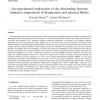Free Online Productivity Tools
i2Speak
i2Symbol
i2OCR
iTex2Img
iWeb2Print
iWeb2Shot
i2Type
iPdf2Split
iPdf2Merge
i2Bopomofo
i2Arabic
i2Style
i2Image
i2PDF
iLatex2Rtf
Sci2ools
106
Voted
CG
2005
Springer
2005
Springer
An experimental exploration of the relationship between subjective impressions of illumination and physical fidelity
Two experiments were carried out to explore the effect of rendering and interface fidelity on subjective impressions of illumination and perceived presence after exposure to a virtual environment (VE). In particular, a study that compares a real-world task situation to its computer graphics simulation counterpart is presented. The computer graphics simulation was based on photometry data acquired in the real-world space and was displayed on either a Head Mounted Display or desktop display utilising either monocular or stereo imagery and interaction interfaces such as the common mouse and head tracking. 105 participants across five conditions were exposed to the real and computer graphics environment and after completing a spatial task, subjective impressions of the illumination and sense of presence assessments were acquired. Relevant results showed a positive correlation between presence and subjective impressions of lighting (e.g. `warm', `comfortable', `spacious', et...
CG 2005 | Computer Graphics | Computer Graphics Simulation | Head Mounted Display | Subjective Impressions |
Related Content
| Added | 15 Dec 2010 |
| Updated | 15 Dec 2010 |
| Type | Journal |
| Year | 2005 |
| Where | CG |
| Authors | Katerina Mania, Andrew Robinson |
Comments (0)

